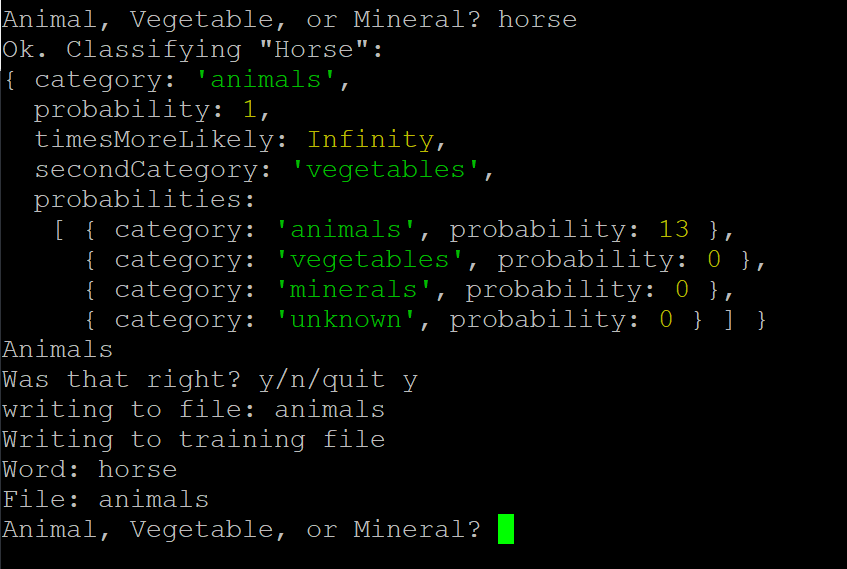Animal Vegetable or Mineral?
Enter a word and I'll try to guess whether it's an animal, a vegetable, or a mineral.

Enter a word and I'll try to guess whether it's an animal, a vegetable, or a mineral.

This is a very simple demonstration of the power of machine learning. It uses a naive bayesian classifier — a basic machine learning algorithm — to determine whether the word that was entered is an animal, a vegetable, or a mineral.
One of the first things I do with AI/ML design is reduce the barrier to entry. With so many of the small-to-medium sized businesses that I've talked to, the question about AI and machine learning is where to start.
I use this example to demonstrate machine learning because it's so simple. In less than 100 lines of code, we have a fully working, fully trainable machine learning based classifier! All of the machine learning code that I create is tiny, free, and open source.
When you enter a word in the search box, the classifier checkes three files: animals, vegetables, and minerals. The file that has the most entries for that word is the category that is returned. These files contain a list of words that have been entered on this site as well as several libraries of plants and animals that I found on the internet, but it still has a lot to learn!
Naive Bayesian Classifiers are called naive because they don't know anything when they start, and they're called Bayesian because they were invented by a dude named Bayes. And they're called classifiers because they classify stuff...
Naive Bayesian classifiers start out completely untrained. This classifier could just as easily classify between three groups of pretty much anything. Until it's trained, it doesn't even know the difference between animals, vegetables, and minerals. All it knows is that that they are different.
If it knows, or if it has a guess, it will tell you it's answer and ask you if it was correct. If it was right (and you tell it that it was right) it will use reinforcement learning to make stronger connections for that guess. If it was wrong you can re-train it to learn the right answer.
When you enter a word that the bot doesn't know, instead of guessing, it will ask you whether it is an animal, a vegetable, or a mineral. Your feedback trains the bot and the next time you ask it that question (or someone else does) it may have a better guess than it did the last time.
Clone or fork the repo
git clone https://github.com/adunderwood/avm
Install dependencies
npm init -y
npm install
Run the tutorial
npm start
// module dependencies
var dclassify = require('dclassify')
var prompt = require('prompt-sync')()
var pluralize = require('pluralize')
var func = require('./functions.js')
// Utilities provided by dclassify
var Classifier = dclassify.Classifier
var DataSet = dclassify.DataSet
var Document = dclassify.Document
var dir = "./avm/"
var userTraining
while ((userTraining != "q") && (userTraining != "quit")) {
var animalsFromFile = func.readFile(dir + "animals.txt")
var vegetablesFromFile = func.readFile(dir + "vegetables.txt")
var mineralsFromFile = func.readFile(dir + "minerals.txt")
// create some 'good' test items (name, array of characteristics)
var itemAnimals = new Document('animalsFromFile', animalsFromFile)
var itemVegetables = new Document('vegetablesFromFile', vegetablesFromFile)
var itemMinerals = new Document('mineralsFromFile', mineralsFromFile)
var itemUnknown = new Document('unknown',[])
// create a DataSet and add test items to appropriate categories
// this is 'curated' data for training
var data = new DataSet()
data.add('animals', itemAnimals)
data.add('vegetables', itemVegetables)
data.add('minerals', itemMinerals)
data.add('unknown', itemUnknown)
// create a classifier
var classifier = new Classifier(options)
// train the classifier
classifier.train(data)
userInput = prompt('Animal, Vegetable, or Mineral? ')
userInput = pluralize.singular(userInput)
console.log('Ok. Classifying \"' + func.sentenceCase(userInput) + '\": ')
// test the classifier on a new test item
var testThis = []
testThis.push(userInput.toLowerCase())
var testDoc = new Document('testDoc', testThis)
var result1 = classifier.classify(testDoc)
// report to the user
console.log(result1)
console.log(func.sentenceCase(result1.category))
userTraining = prompt('Was that right? y/n/quit ')
var firstLetter = userTraining[0]
switch (firstLetter) {
case "y":
func.writeFile(result1.category, userInput, dir)
break
case "n":
var tmpInput = prompt("What is the right category? ")
func.correctFile(tmpInput, userInput, dir)
break
default:
console.log("No action taken.")
}
}
